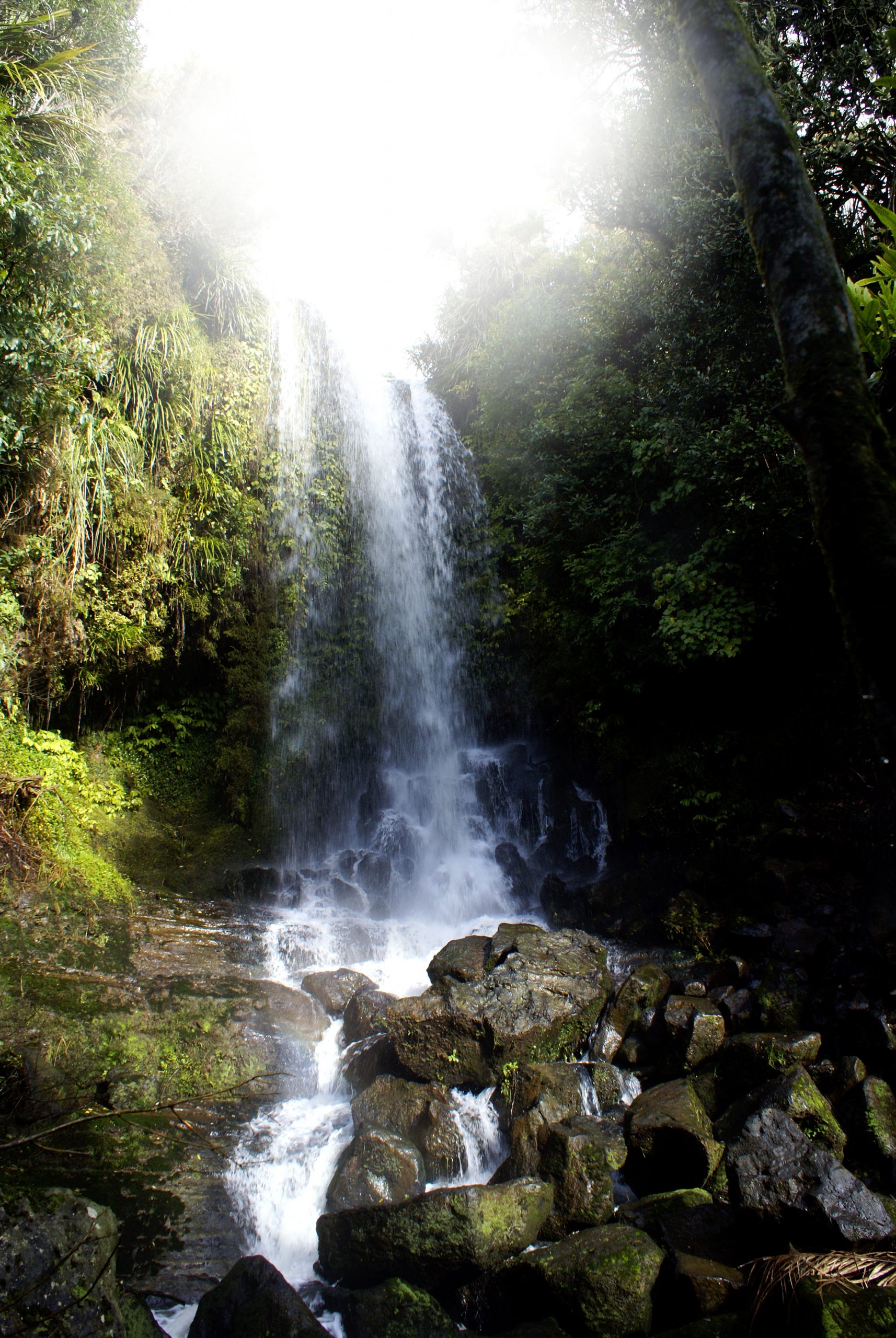
Legends dwell in just about every nook of New Zealand. One such legend tells of a dramatic way that Te Ruinga, a mighty warrior, tested his men’s bravery. To find the bravest men to fight against the tyrant Tapaue, Te Ruinga traveled to Te Wai Heke o Maoa (Maoa’s Waterfall). He dammed up the river at the top of the hill, while his warriors lay on the streambed below. When Te Ruinga released the water full force upon his soldiers, they did not flinch. Their bravery later led them to victory against Tapaue, freeing their people from his tyranny.
It has been many years since the time of Te Ruinga, but visitors still feel an almost supernatural connection-—known as mana—to the land and its history. American Anita Torres, a seven-year resident of New Zealand, felt that connection when she ventured with her daughter, Megan Andrews, on a “bushwalk” through Harker Reserve, home of the Te Wai Heke o Maoa waterfall in the city of Onewhero.
“When we stepped through the trees into the hidden land of the waterfall,” says Torres, “I felt the mana of the Māori warriors who had come to this place not only to prove their bravery but to draw strength from the power of the water and the land. It is a place outside of time, and the past seemed to be dwelling alongside the present.”
Nature’s Welcome
The atmosphere quieted as mother and daughter began their trek through the forest. It was as though they had stepped into Mother Nature’s private chamber. Trees rose high into the sky, diminishing the sunlight. “There was a broad path, and then suddenly we saw a little signpost inviting us to go off the trail,” says Torres. As they stepped off the wider trail, the less-traveled path became much wilder and more isolated, providing a more intimate experience and allowing them to lose themselves in the same forest that Te Ruinga’s warriors knew so well ages ago.
Torres and her daughter were greeted by the local fantails, one of the bird varieties New Zealand is known for. “As we trudged through the bush,” says Torres, “a little fantail danced along the path in front of us, encouraging us onward, chattering all the way like a cassette tape on fast forward.” The more the birds’ prattl-ing filled the air, the more the hikers delved into Nature’s territory, where trees grew close together and roots became their stepping-stones.
Nature’s Power
A powerful mist dowsed the visitors before they could even see the falls. But more astounding was the sight of the falls, cascading down 20 feet onto giant, moss-covered boulders. No barriers separated the hikers from the towering waterfall or from its roaring flow washing past.
Drawn to the power of the falls, Andrews stepped away from her mother toward the slippery rocks, determined to climb close enough to touch the water. “I was nervous that the water could drag me in and carry me away,” she says. “But when I touched it, I just felt so connected with this place.” The thrill coursed through her as she climbed back, soaking wet, to her mother.
The draw to the New Zealand wilderness is a call difficult to ignore. Just as the legend of Te Ruinga and the power of Te Wai o Maoa enticed these women to have a spiritual experience, New Zealand’s hallowed sanctuaries of time and nature still draw adventurers from around the world.
Clarise Insch


I have always wanted to travel to New Zealand. My family has roots there and my father has always wanted to take the family there; to see his old stomping grounds, to show off the land he is so proud of. Being Polynesian myself, I felt drawn to this particular article and I’m glad I read it. If time ever allows me to travel to the land of my ancestors and family, I will have an idea of what to do and what to see. 🙂
From the very get-go, I felt that this article had a lot of mystery. I love the idea of legends and myths, it makes you feel a little like Indiana Jones or something. There was a lot of really great anecdotes and some really awesome imagery. Visiting New Zealand has always been a dream of mine, so reading a bit about the beautiful scenery there was a really fun experience!
The beauty in this article is hardly surpassed by the beauty of the photo. Thank you for so well-written an article. I love the blending of history and local legend with the near-mystical modern day experience that someone travelling to the falls can have. Bravo!
I’ve been really interested in New Zealand for the past couple of years—admittedly, Lord of the Rings has something to do with that—so this article was really interesting to me. I enjoyed learning more about the local legends and nature.
Hey sweetie you’re website is gem! Thanks for keeping it simple.
Beautiful photos and a beautiful article. It’s amazing how nature can kind of transport us to a different world.